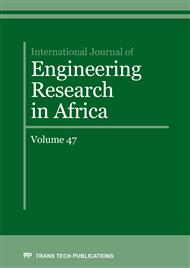[1]
R. Ravisankar, K. Vanasundari, A. Chandrasekaran et al., Measurment of natural radioactivity in brick sample of Namakkal, Tamilnadu, India using gamma-ray spectrometry, Arch. Phys. Res. 2(2) (2011) 95-99.
Google Scholar
[2]
H. Al-Zahrani, Radioactivity Measurements and Radiation Dose assessments in Soil of Albaha Region, Life Sci. J. 9(3) (2012) 2391-239.
Google Scholar
[3]
H. Hewamanna, et al. Natural radioactivity and gamma dose from Sri Lankan clay bricks used in building construction, Appl. Rad. Isot. 54(2001) 365-369.
DOI: 10.1016/s0969-8043(00)00107-x
Google Scholar
[4]
M.A. Mahmoud Uosif Specific Activity of 226Ra, 232Th and 40K for Assessment of Radiation Hazards from Building Materials Commonly Used in Upper Egypt, SDU J. Sci. 6 (2) (2011) 120-126.
Google Scholar
[5]
R. Ravisankar et al. Measurement of Natural Radioactivity in Brick samples of Namakkal, Tamilnadu, India using Gamma -ray Spectrometry, Sch. Res. Libr.. 2(2) (2011) 95-99.
Google Scholar
[6]
I. Noorddin, Natural activities of 238U, 232Th and 40K in building materials, J. Envi. Radio. 43 (1998) 255-258.
Google Scholar
[7]
L. Xinwei L., Natural radioactivity in some building materials of Xi'an, China. Radiat. Meas. 40 (2005) 94–97.
Google Scholar
[8]
Y. Ya-Xin, W. Xin -Min, J. Zhong-ying et al., Radioactivity concentrations in soils of the Xiazhuang granite area, China, Appl. Radi. Isot. 63(2005) 255–259.
Google Scholar
[9]
J. Amiri, S.P. Shirmardi, J.P. Eslamian, Measuring natural radioactivity of bricks used in the constructions of Teheran, J. Param. Sci. 5(3) (2014) 58-62.
Google Scholar
[10]
H. Florou, P. Kritidis, Gamma radiation measurements and dose rate in the coastal areas of a volcanic Island, Aegean Sea, Greece. Radia. Protec. Dosim. 45 (1) (1992) 277-279.
DOI: 10.1093/rpd/45.1-4.277
Google Scholar
[11]
UNSCEAR (United Nations Scientific Committee on the Effects of Atomic Radiation). Report of the United Nations Scientific Committee on the Effects of Atomic Radiation 2010; United Nations: New York, NY, USA, (2010).
DOI: 10.18356/1b01bffb-en
Google Scholar
[12]
E.E. Belgin, G.A. AYCIK, 226Ra, 232Th and 40K Activity concentrations and radiological hazards of building materials in Mugla, J. Sci. Tech., Vol 1 (2) (2015) 11-15.
Google Scholar
[13]
AEA, International BasicSafety Standards for Protection Against Ionizing Radiation and for the Safety of Radiation Sources. IAEA Safety Series No. 115, (1996).
Google Scholar
[14]
OECD, Exposure to radiation from natural radioactivity in building materials, Report by Group of Experts of the OECD Nuclear Energy Agency, Paris, France, (1979).
Google Scholar
[15]
European Commission Radiation Protection 112, directorate. General environment, nuclear safety and civil production, (1999).
Google Scholar
[16]
EC, Radiological protection principles concerning the natural radioactivity of building materials. European Commission. Radiation Protection Unit. Radiat. Prot.112, (1999).
Google Scholar
[17]
UNSCEAR (United Nations Scientific Committee on the Effects of Atomic Radiation). Biological Mechanisms of Radiation Actions at Low Doses. United Nations Scientific Committee on the Effects of Atomic Radiation UNSCEAR; United Nations: New York, NY, USA, (2012).
DOI: 10.18356/009b17a5-en
Google Scholar


